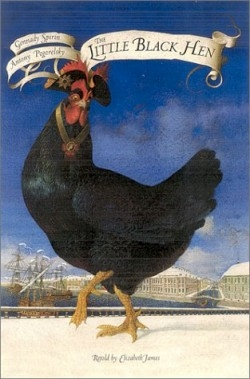The Little Black Hen
This Russian fairy tale is rich with action, enchantment, and moral choices, and clearly aimed toward a sophisticated elementary school audience. Written by nineteenth-century Russian novelist Antony Pogorelsky (also a collector of Russian folktales, legends, and magical stories), and retold here by a prolific children’s book author, this tale is beautifully illustrated in a style reminiscent of Renaissance masters.
Alyosha, a boarding school student, rescues a little black hen from the cook’s knife. The hen turns out to be the enchanted ambassador of a kingdom of little people, and brings the boy on a mystical late-night visit to her underground world. There, Alyosha is rewarded for his good deed with a magic seed of corn that enables him to know his school lessons without having to study. He is sent back to regular life with a warning from the country’s king: “If you tell anyone about our underground kingdom you will destroy our happiness and bring us much hardship.” In the world of fairy tales, such ultimatums are meant to be broken. Alyosha’s betrayal of the kingdom and ultimate redemption make for riveting, if predictable, reading.
The illustrator has won numerous awards, including having four books named “Best Illustrated Book of the Year” by the New York Times. He employs the same richly colored, realistic style in the watercolor illustrations for this tale. His depictions of Alyosha convey his development throughout the story more powerfully than the text. Detailed facial expressions bring the boy to life from the very first page, which shows Alyosha bored among his history books in a slack-jawed posture with which any school-aged child can identify.
The reader experiences Alyosha’s wondrous fascination among the little people, his confidence spouting off lessons with the magic seed in his pocket, and his tearful breakdown as he betrays the kingdom, in full-page paintings that convey every nuance of emotion. On the last page of the story, Alyosha gazes out at the reader having “returned to classes determined to set a fine example from that day forward.” His confidence and resolve are apparent in his posture and his self-assured smile, so much more mature than the bored child sprawled in a chair at the story’s opening.
Admirers of Spirin’s artwork will appreciate this newest offering, which is similar in style to his other fairy tale books. Children who enjoy folk and fairy tales will be intrigued by this story, which combines the traditional motifs of magic and challenges in a fresh presentation. With its clear moral lesson about the importance of studying and treating others well, adults may find this story of use in opening a discussion of these values.
Reviewed by
Carolyn Bailey
Disclosure: This article is not an endorsement, but a review. The publisher of this book provided free copies of the book to have their book reviewed by a professional reviewer. No fee was paid by the publisher for this review. Foreword Reviews only recommends books that we love. Foreword Magazine, Inc. is disclosing this in accordance with the Federal Trade Commission’s 16 CFR, Part 255.

